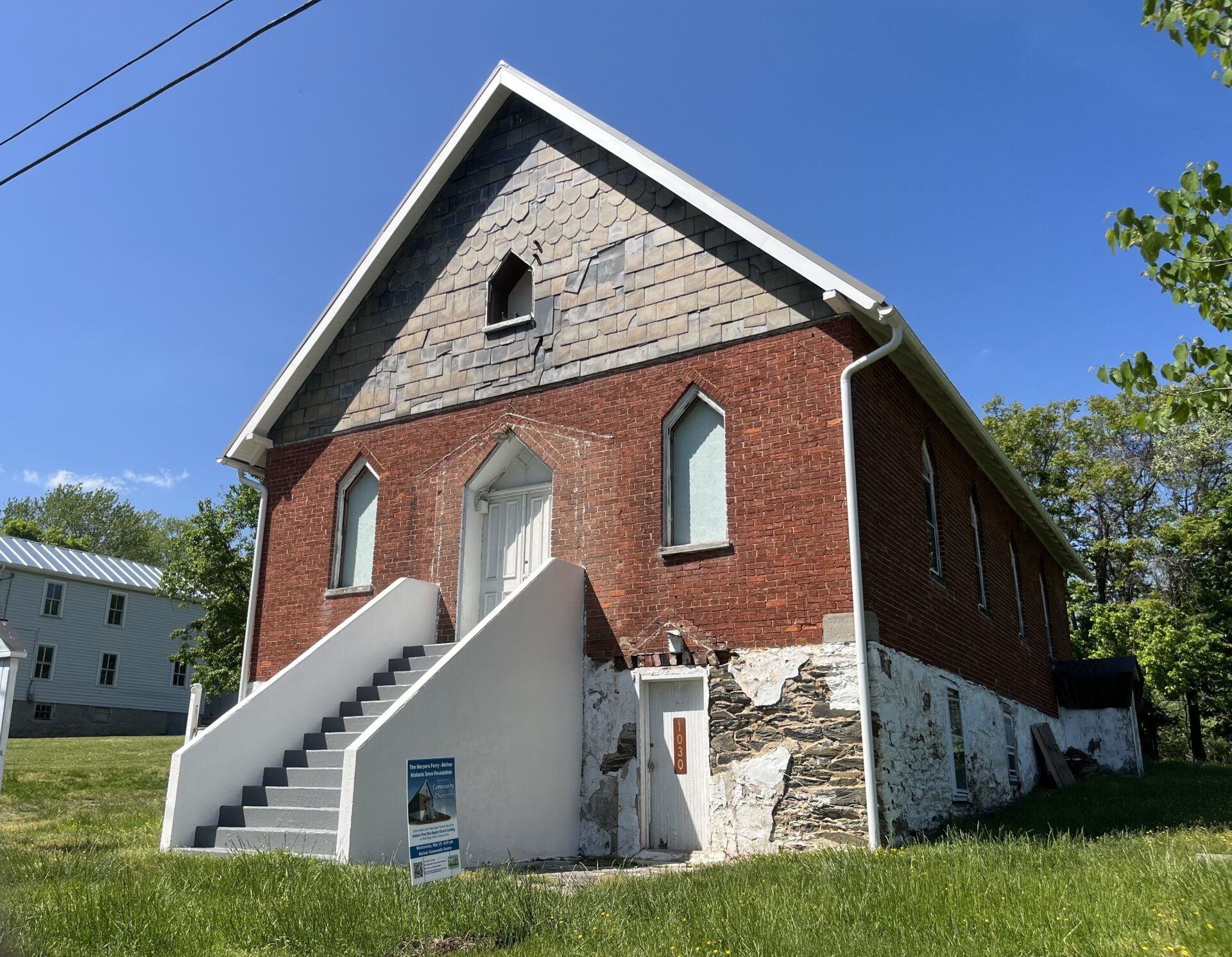On May 14, residents of Harpers Ferry and Bolivar in Jefferson County poured into a community forum in town. Attendees greeted neighbors and stuffed paper plates with cookies and pepperoni rolls before settling into their seats.
The forum was an opportunity for residents to provide feedback on the restoration of First Zion Baptist Church, which was built by members of Harpers Ferry’s Black community in 1894.
For decades, First Zion hummed with sermon and song. But it shuttered in 1991, just shy of its hundredth anniversary. Then the building slowly fell into disrepair until a local preservationist society purchased it in 2016.
“We’ve been working slowly ever since then, trying to raise money and making improvements and protecting the church where we can,” said Lynn Pechuekonis, chair of the Harpers Ferry-Bolivar Historic Town Foundation.
Pechuekonis said the group wants to preserve a fixture of 20th century Black history, when Harpers Ferry was a meeting ground for civil rights leaders and home to the historically Black Storer College.
This year, the group received a $100,000 grant from the National Trust for Historic Preservation to do just that. The grant comes from the Trust’s African American Cultural Heritage Action Fund.
This fund aims to “help historic Black churches and congregations reimagine, redesign and redeploy historic preservation” to address the contemporary needs of Black churches nationally, according to Renee Ingram, founder of the African American Heritage Preservation Foundation.
The restoration of First Zion is part of a broader move toward “adaptive reuse” for Black cultural sites no longer in use for religious purposes, Ingram wrote in a message to West Virginia Public Broadcasting.
With the new grant, Pechuekonis said her organization hopes to transform the broken-down building into a community center or religious institution that pays homage to local Black history.
“We would like to have some kind of display honoring the Black community that lived here, and especially the history of that church,” she said.
Photo Credit: Jack Walker/West Virginia Public Broadcasting
While Pechuekonis estimated that the First Zion restoration is still three to five years away from completion, similar restoration projects are underway across the country, according to k. kennedy Whiters, AIA.
Whiters is a preservationist based in New York who founded Black in Historic Preservation — an organization that provides professional support to Black preservationists in the United States and beyond.
She said efforts to restore or preserve churches like First Zion are not uncommon. But the process can be tricky because of the politics of preservation as a field.
To access grants or protective statuses, preservationists have to prove a site has historical significance. And Black churches are rich with history.
When Black parishioners have been excluded or outright barred from white churches during slavery, segregation and even today, Black churches offered community building, financial support and political organizing.
In West Virginia, Booker T. Washington attended services in Malden, and Martin Luther King Jr. addressed a Black congregation in Charleston. But Whiters said racial biases have led many institutions to overlook or even dismiss the importance of this history.
“Oftentimes, with what’s considered to be the significant history of the United States, that does not include the history of Black people, Black and Brown people, LGBTQIA people,” she said.
Buildings typically must also meet a threshold of structural integrity to be preserved in their original forms.
Again, Whiters said this puts Black historical sites at a disadvantage, because Black communities are historically under-resourced. In the 20th century, white-owned banks seldom offered loans for projects in Black neighborhoods, denying their communities robust building materials.
“Allowing the infrastructure and the integrity of a building to erode” because Black Americans “cannot gain access to capital” means, decades later, “we will have a building that does not have integrity,” she said.
To address this, Whiters and other preservationists have partnered with local governments and institutions to reexamine conservation criteria.
Other workarounds include repurposing pieces of a historic site — like its bricks, doors or foundation — while reconstructing portions of the building that don’t meet current standards.
Photo Credit: Curtis Tate/West Virginia Public Broadcasting
Efforts like these help preserve the architectural history of Black churches. But equally important is preserving Black religious institutions themselves, according to Reverend Paul Dunn with First Baptist Church in Charleston.
Dunn said dwindling church turnout from younger generations, plus years of population decline in West Virginia, bring challenges to the congregation. He said part of the solution is expanding the church’s digital footprint.
“Our services are broadcast on BoxCast, Facebook Live and TikTok as well as YouTube,” he said. “So we have navigated some of the trials of declining membership by having the FBC virtual community.”
Dunn said hundreds of people across the country, and a couple of parishoners abroad, tune in for the weekly service. Keeping this network alive helps secure offerings for the church.
While First Baptist has changed location since its founding, Dunn said these virtual gifts help fund the current building’s upkeep, ensuring its continued use in the years ahead.
For Whiters, the preservation of Black churches across West Virginia and the United States speaks to the presence of Black culture nationwide.
Protecting these spaces can deepen public understanding that Black Americans hold roots across the country, even in areas that are predominantly white today, Whiters said.
Plus, they remind residents of the cultural circumstances that demanded the creation of many Black cultural spaces — like segregation and anti-Black violence.
“It’s important because it helps to say that we were here and that we’re still here,” she said. “Just to connect us … as Black people to our roots across the country.”
